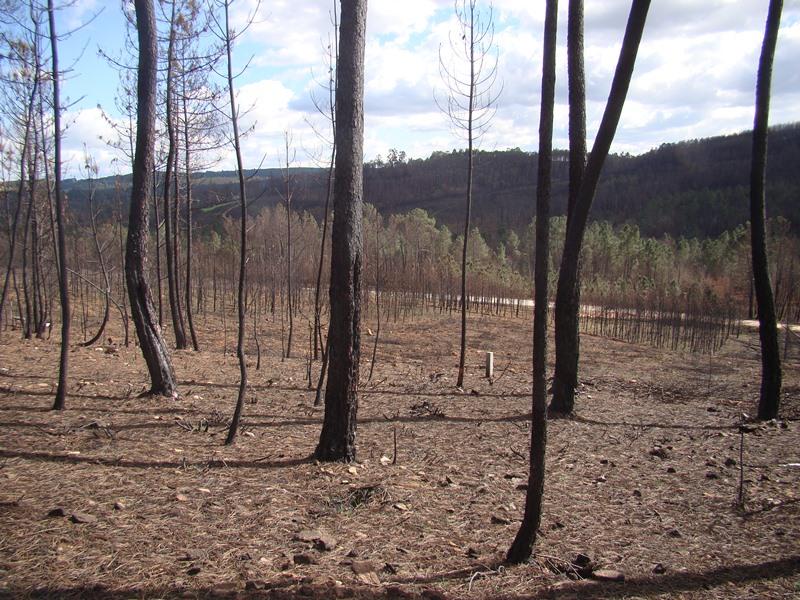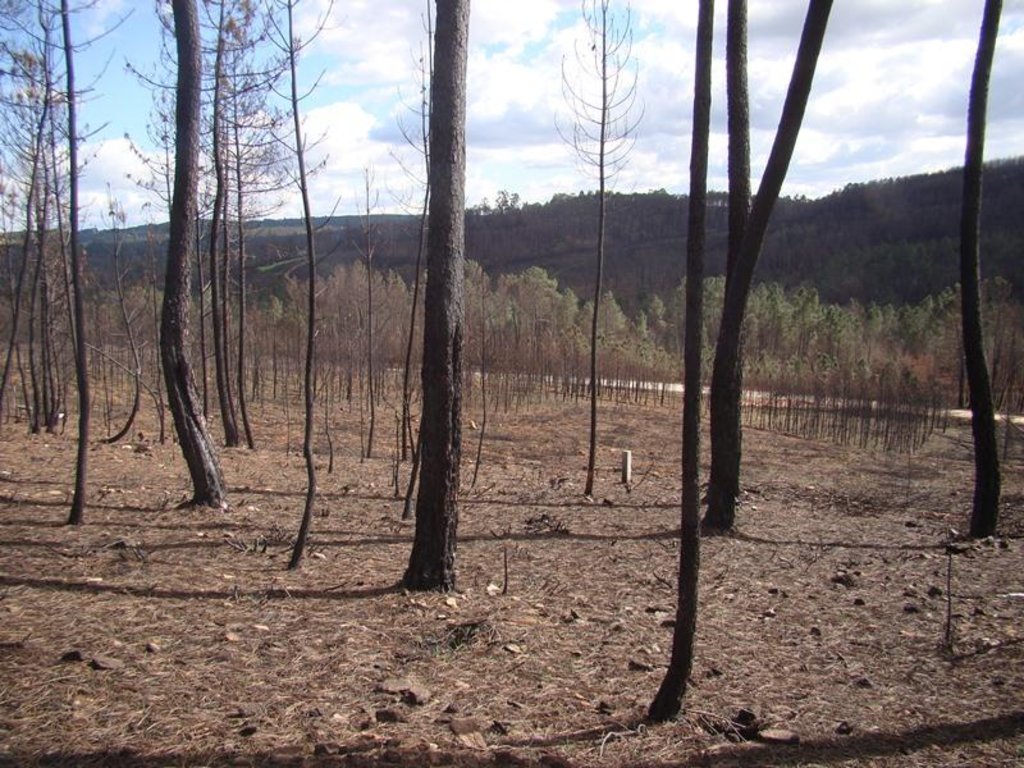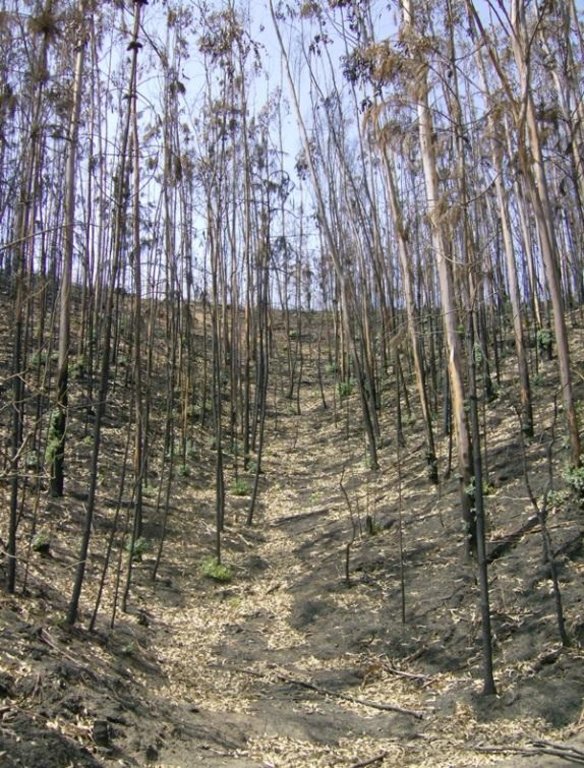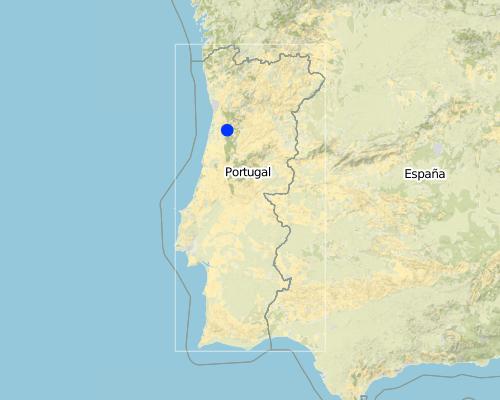Post-fire Natural Mulching [Portugal]
- Criação:
- Atualização:
- Compilador/a: Sergio Prats Alegre Prats
- Editor: –
- Revisor: Fabian Ottiger
No intervention, needle carpet, caruma (Portuguese)
technologies_1298 - Portugal
Veja as seções
Expandir tudo Recolher tudo1. Informação geral
1.2 Detalhes do contato das pessoas capacitadas e instituições envolvidas na avaliação e documentação da tecnologia
Especialista em GST:
Especialista em GST:
Keizer Jan Jacob
+ 351 234 370200
jjkeizer@ua.pt.
Centre for Environmental and Marine Studies (CESAM) - Department of Environment and Planning-University of Aveiro
Campus de Santiago, 3810-193 Aveiro, Portugal
Portugal
Especialista em GST:
Nome do projeto que facilitou a documentação/avaliação da Tecnologia (se relevante)
Preventing and Remediating degradation of soils in Europe through Land Care (EU-RECARE )Nome do projeto que facilitou a documentação/avaliação da Tecnologia (se relevante)
Catastrophic shifts in drylands (EU-CASCADE)Nome da(s) instituição(ões) que facilitou(ram) a documentação/ avaliação da Tecnologia (se relevante)
University of Aveiro (University of Aveiro) - PortugalNome da(s) instituição(ões) que facilitou(ram) a documentação/ avaliação da Tecnologia (se relevante)
Fundação para a Ciência e a Tecnologia (FCT) - Portugal1.3 Condições em relação ao uso da informação documentada através de WOCAT
Quando os dados foram compilados (no campo)?
04/10/2007
O/a compilador/a e a(s) pessoa(s) capacitada(s) aceitam as condições relativas ao uso de dados documentados através da WOCAT:
Sim
2. Descrição da tecnologia de GST
2.1 Descrição curta da tecnologia
Definição da tecnologia:
In certain situations, the leaves from the burnt trees created a natural carpet that protect the soil from being eroded.
2.2 Descrição detalhada da tecnologia
Descrição:
In the 2007 summer a wildfire affected the locality of Pessegueiro do Vouga, municipality of Sever do Vouga, north-central Portugal. The area was afforested with eucalypt and pine plantations. The research team of the University of Aveiro checked that in some burnt areas the crown damage was very small, despite the litter and underground vegetation were totally consumed by fire. The pine site presented a markedly lower fire severity, with the canopies only partially consumed by the fire, so it allow to study the effect of fire severity on soil erosion by comparison with adjacent slopes burned a high severity.
Purpose of the Technology: In a wildfire that affected a pine plantation in central Portugal in 2007, the research team of the University of Aveiro set up an experiment in order to test the effect of forest residue mulching as a soil erosion mitigation treatment. However, the low fire severity resulted in an elevated litter cover prior any technique was applied. The objective is to determine were “no action” in post-fire management will still result in low soil erosion values.
Establishment / maintenance activities and inputs: The high litter cover will decrease post-fire soil erosion by reducing raindrop impact over the ashes and the bare soil, and decrease the runoff amount by increasing water surface storage, decrease of runoff velocity, and increase infiltration. As the needle litter cover was natural, no action was needed. After a simple assessment of the remaining ground cover in the burnt area, the "no intervention" option should be selected if the soil is covered by litter, leaves or needles. The benefits of this are not only the mitigation of soil erosion (and associated soil fertility losses) immediately after forest fires, but also the long-term conservation of the soil resources without additional costs.
Natural / human environment: The landscape reflects a long history of intense land management, with a mosaic of (semi-)natural and man-made agricultural and afforested lands. Since the 1980´s, however, wildfires have increased dramatically in frequency and extent, aided by a general warming and drying trend but driven primarily by socio-economic changes.
2.3 Fotos da tecnologia
2.5 País/região/locais onde a tecnologia foi aplicada e que estão cobertos nesta avaliação
País:
Portugal
Região/Estado/Província:
Portugal, Aveiro
Especificação adicional de localização:
Sever do Vouga, Pessegueiro de Vouga
Map
×2.6 Data da implementação
Caso o ano exato seja desconhecido, indique a data aproximada:
- menos de 10 anos atrás (recentemente)
2.7 Introdução da tecnologia
Especifique como a tecnologia foi introduzida:
- durante experiências/ pesquisa
3. Classificação da tecnologia de GST
3.2 Tipo(s) atualizado(s) de uso da terra onde a tecnologia foi aplicada

Floresta/bosques
Produtos e serviços:
- Madeira
- Lenha
Comentários:
Major land use problems (compiler’s opinion): Strong increases in runoff and erosion should be a main land management concern following wildfires, as they constitute a serious threat to land-use sustainability and downstream aquatic habitats and human infrastructures. The forest owners and managers need to establish target areas to apply cost-effective post-fire soil erosion mitigation treatments, included the “no action” option.
Major land use problems (land users’ perception): Loss of wood resources and productivity.
Plantation forestry: Pines logged every 30 years, after fire natural regeneration if possible, but mainly after fire there is a change to eucalypt plantations
Forest products and services: timber, fuelwood
3.3 Mais informações sobre o uso da terra
Número de estações de cultivo por ano:
- 3
Especifique:
Longest growing period in days: 270Longest growing period from month to month: September to May
3.4 Grupo de GST ao qual pertence a tecnologia
- Solo/cobertura vegetal melhorada
3.5 Difusão da tecnologia
Especifique a difusão da tecnologia:
- Uniformemente difundida numa área
Caso a tecnologia seja uniformemente difundida numa área, indique a área coberta aproximada:
- < 0,1 km2 (10 ha)
Comentários:
Total area covered by the SLM Technology is 1.0E-5 m2.
3.6 Medidas de GST contendo a tecnologia

Medidas agronômicas
- A1: cobertura vegetal/do solo
Comentários:
Secondary measures: agronomic measures
Type of agronomic measures: mulching
3.7 Principais tipos de degradação da terra abordados pela tecnologia

Erosão do solo pela água
- Wt: Perda do solo superficial/erosão de superfície
- Wo: efeitos de degradação externa

Deteriorização física do solo
- Pk: quebra e ressecamento
Comentários:
Main type of degradation addressed: Wt: loss of topsoil / surface erosion
Secondary types of degradation addressed: Wo: offsite degradation effects, Pk: sealing and crusting
Main causes of degradation: soil management (Land use change has been associated to increasing fire frequency in the region), deforestation / removal of natural vegetation (incl. forest fires) (Pine plantations are prone to fire), population pressure (Since the 80´s land use had change to increase afforestation with flammable species (i.e. pine and eucalypts))
3.8 Redução, prevenção ou recuperação da degradação do solo
Comentários:
Main goals: prevention of land degradation, mitigation / reduction of land degradation
Secondary goals: rehabilitation / reclamation of denuded land
4. Especificações técnicas, implementação de atividades, entradas e custos
4.1 Desenho técnico da tecnologia
4.2 Especificações técnicas/ explicações do desenho técnico
Natural mulch is often present in areas burnt at low severity or only partially burnt (3). This areas as well as planar areas (2) must be areas for no mitigation treatment or “no action” after forest fires.
Main technical functions: control of raindrop splash, control of dispersed runoff: retain / trap, control of concentrated runoff: retain / trap, improvement of ground cover, increase of surface roughness, increase of infiltration, sediment retention / trapping, sediment harvesting, increase of biomass (quantity)
Secondary technical functions: control of dispersed runoff: impede / retard, control of concentrated runoff: impede / retard, improvement of surface structure (crusting, sealing), improvement of topsoil structure (compaction), increase in organic matter, increase in nutrient availability (supply, recycling,…), increase / maintain water stored in soil
Mulching
Material/ species: natural needle carpet
Remarks: Up to 50% litter cover
4.4 Atividades de implantação
| Atividade | Tipo de medida | Periodicidade | |
|---|---|---|---|
| 1. | Natural cover | Agronômico |
4.8 Fatores mais importantes que afetam os custos
Descreva os fatores mais determinantes que afetam os custos:
No cost are envisaged for this technology. Visual assessment of the soil cover can be susceptible for costs, for example consulting, but we think it is not eligible.
5. Ambiente natural e humano
5.1 Clima
Precipitação pluviométrica anual
- <250 mm
- 251-500 mm
- 501-750 mm
- 751-1.000 mm
- 1.001-1.500 mm
- 1.501-2.000 mm
- 2.001-3.000 mm
- 3.001-4.000 mm
- > 4.000 mm
Zona agroclimática
- úmido
- Subúmido
Thermal climate class: subtropics
Thermal climate class: temperate
5.2 Topografia
Declividade média:
- Plano (0-2%)
- Suave ondulado (3-5%)
- Ondulado (6-10%)
- Moderadamente ondulado (11-15%)
- Forte ondulado (16-30%)
- Montanhoso (31-60%)
- Escarpado (>60%)
Formas de relevo:
- Planalto/planície
- Cumes
- Encosta de serra
- Encosta de morro
- Sopés
- Fundos de vale
Zona de altitude:
- 0-100 m s.n.m.
- 101-500 m s.n.m.
- 501-1.000 m s.n.m.
- 1.001-1.500 m s.n.m.
- 1.501-2.000 m s.n.m.
- 2.001-2.500 m s.n.m.
- 2.501-3.000 m s.n.m.
- 3.001-4.000 m s.n.m.
- > 4.000 m s.n.m.
5.3 Solos
Profundidade do solo em média:
- Muito raso (0-20 cm)
- Raso (21-50 cm)
- Moderadamente profundo (51-80 cm)
- Profundo (81-120 cm)
- Muito profundo (>120 cm)
Textura do solo (solo superficial):
- Médio (limoso, siltoso)
Matéria orgânica do solo superficial:
- Alto (>3%)
Caso disponível anexe a descrição completa do solo ou especifique as informações disponíveis, p. ex. tipo de solo, PH/acidez do solo, nitrogênio, capacidade de troca catiônica, salinidade, etc.
Topsoil organic matter is high (forest soil)
Soil fertilits is medium
Soil drainage/infiltration is medium - poor (fire reduce soil infiltration capacity. Also, soil water repellency is present).
Soil water storage capacity is low
5.4 Disponibilidade e qualidade de água
Lençol freático:
> 50 m
Disponibilidade de água de superfície:
Médio
Qualidade da água (não tratada):
Água potável boa
5.5 Biodiversidade
Diversidade de espécies:
- Baixo
Comentários e outras especificações sobre biodiversidade:
Forest plantation
5.6 Características dos usuários da terra que utilizam a tecnologia
Rendimento não agrícola:
- 10-50% de toda renda
Nível relativo de riqueza:
- Pobre
- Média
Indivíduos ou grupos:
- Grupos/comunidade
Gênero:
- Mulheres
- Homens
Indique outras características relevantes dos usuários da terra:
Land users applying the Technology are mainly common / average land users
Population density: 50-100 persons/km2
40% of the land users are average wealthy and own 30% of the land.
60% of the land users are poor and own 70% of the land.
Market orientation of production system: subsistence (self-supply), mixed (subsistence/ commercial, commercial/ market
5.7 Média da área de terra própria ou arrendada por usuários da terra que utilizam a tecnologia
- < 0,5 ha
- 0,5-1 ha
- 1-2 ha
- 2-5 ha
- 5-15 ha
- 15-50 ha
- 50-100 ha
- 100-500 ha
- 500-1.000 ha
- 1.000-10.000 ha
- > 10.000 ha
É considerado pequena, média ou grande escala (referente ao contexto local)?
- Pequena escala
Comentários:
Average area of land owned or leased by land users applying the Technology: 2-5 ha, 5-15 ha, 15-50 ha
5.8 Propriedade de terra, direitos de uso da terra e de uso da água
Propriedade da terra:
- Empresa
- Indivíduo, não intitulado
5.9 Acesso a serviços e infraestrutura
Saúde:
- Pobre
- Moderado
- Bom
Educação:
- Pobre
- Moderado
- Bom
Assistência técnica:
- Pobre
- Moderado
- Bom
Emprego (p. ex. não agrícola):
- Pobre
- Moderado
- Bom
Mercados:
- Pobre
- Moderado
- Bom
Energia:
- Pobre
- Moderado
- Bom
Vias e transporte:
- Pobre
- Moderado
- Bom
Água potável e saneamento:
- Pobre
- Moderado
- Bom
Serviços financeiros:
- Pobre
- Moderado
- Bom
6. Impactos e declarações finais
6.1 Impactos no local mostrados pela tecnologia
Impactos socioeconômicos
Produção
Produção de madeira
Comentários/especificar:
Some reduced wood production can be associated to the technique by carrying out selective felling.
Impactos socioculturais
Conhecimento de GST/ degradação da terra
Comentários/especificar:
Public awareness of the technology is very limited. It is necessary to show it to landowners and stakeholders and increase dissemination.
Improved livelihoods and human well-being
Impactos ecológicos
Ciclo hídrico/escoamento
Escoamento superficial
Evaporação
Solo
Umidade do solo
Cobertura do solo
Perda de solo
Ressecamento/ selagem do solo
Compactação do solo
Clima e redução de riscos de desastre
Risco de incêndio
6.2 Impactos externos mostrados pela tecnologia
Cheias de jusante
Danos em áreas vizinhas
Danos na infraestrutura pública/privada
6.3 Exposição e sensibilidade da tecnologia às mudanças climáticas graduais e extremos/desastres relacionados ao clima (conforme o ponto de vista dos usuários da terra)
Mudança climática gradual
Mudança climática gradual
| Estação do ano | Tipo de mudança climática/extremo | Como a tecnologia lida com isso? | |
|---|---|---|---|
| Temperatura anual | aumento | bem |
Extremos (desastres) relacionados ao clima
Desastres meteorológicos
| Como a tecnologia lida com isso? | |
|---|---|
| Temporal local | não bem |
| Tempestade de vento local | bem |
6.4 Análise do custo-benefício
Como os benefícios se comparam aos custos de implantação (do ponto de vista dos usuários da terra)?
Retornos a curto prazo:
muito positivo
Retornos a longo prazo:
muito positivo
Como os benefícios se comparam aos custos recorrentes/de manutenção(do ponto de vista dos usuários da terra)?
Retornos a curto prazo:
muito positivo
Retornos a longo prazo:
muito positivo
Comentários:
As natural mulching has no cost, any benefit is always very positive
6.5 Adoção da tecnologia
Comentários:
Comments on spontaneous adoption: The land users are not aware about the advantages of natural mulching, but in fact they apply it when they have not economic resources.
There is a moderate trend towards spontaneous adoption of the Technology
Comments on adoption trend: Some times logging after fire reduces the natural mulching capacity to prevent post-fire erosion
6.7 Pontos fortes/vantagens/oportunidades da tecnologia
| Pontos fortes/vantagens/oportunidades na visão do usuário da terra |
|---|
| No cost |
| Pontos fortes/vantagens/oportunidades na visão do/a compilador/a ou de outra pessoa capacitada |
|---|
|
It is a technology with no associated cost and with low failure possibilities and a strong soil erosion control. How can they be sustained / enhanced? Inform land owners and forest managers to avoid post-fire logging in areas with natural mulching and therefore avoid the decrease in the technology effeciency. Some times logging after fire reduces the natural mulching capacity to prevent post-fire erosion. |
6.8 Pontos fracos, desvantagens/riscos da tecnologia e formas de superá-los
| Pontos fracos/desvantagens/riscos na visão do usuário da terra | Como eles podem ser superados? |
|---|---|
| No possible to harvest the logs during the first period after the fire | Assume the cost of selective felling |
| Pontos fracos/vantagens/riscos na visão do/a compilador/a ou de outra pessoa capacitada | Como eles podem ser superados? |
|---|---|
| Some people argue that can increase fire risk | Fire risk will not be probably increase as the surrounded areas were frequently also burned |
7. Referências e links
7.2 Referências às publicações disponíveis
Título, autor, ano, ISBN:
Prats SA, MacDonald LH, Monteiro M, Ferreira AJD, Coelho COA, KeizerJJ. 2012. Effectiveness of forest residue mulching in reducing post-firerunoff and erosion in a pine and a eucalypt plantation in north-centralPortugal. Geoderma 191: 115–124.
Título, autor, ano, ISBN:
Shakesby RA, Boakes JD, Coelho COA, Bento-Gonçalves JA, Walsh RPD.1996. Limiting the soil degradational impacts of wildfire in pine and eucalyptusforests in Portugal. Applied Geography 16: 337–355.
Título, autor, ano, ISBN:
RECARE project: Preventing and Remediating degradation of soils in Europe trhough Land Care. http://www.recare-project.eu/
Links e módulos
Expandir tudo Recolher tudoLinks
Não há links
Módulos
Não há módulos






